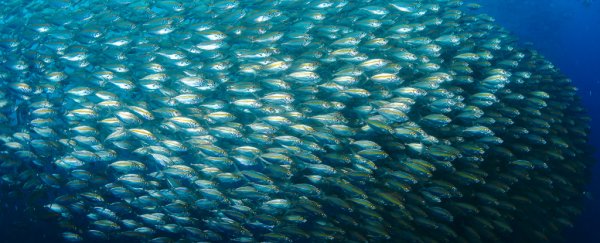By 2100, we could be heading towards a loss of life in our oceans that rivals some of the largest extinction events in Earth's history – if we don't continue to tackle the climate catastrophe, new modeling warns.
But "it is not too late to enact the reductions in greenhouse gas emissions needed to avoid a major extinction event," Princeton geoscientists Justin Penn and Curtis Deutsch explain in their paper.
Using modeling calibrated against ancient fossil records, they predict the consequences of runaway climate change on marine animals and provide a plausible explanation for an enduring ocean mystery in the process.
The geoscientists found that we're essentially replicating a similar pattern seen during the 'Great Dying', 252 million years ago, when volcanoes spewing greenhouse gasses along with methane belching microbes rapidly amped up Earth's temperatures, extinguishing as much as 90 percent of all marine animal species.
As we continue to funnel the exhaust from fossil fuels into our atmosphere, the excess heat is changing the ocean's chemistry and reducing its capacity to hold oxygen. The new study takes into account a well-studied relationship between oxygen, temperature and the physiological limits of different species; the conclusion suggests our current warming trajectory will lead to a mass extinction at a scale we've not seen since the loss of non-avian dinosaurs.
This is without even taking into account further changes in marine chemistry that will follow – ocean acidification – which will wipe out even more species.
Today warming is already driving marine life towards cooler seas, dropping levels of ocean oxygen globally, bleaching reefs, decimating kelp forests and, in weird blobs of warm water, suffocating masses of animals to death.
"Climate change is, in effect, walking species off the ends of the Earth," explain Rutgers University ecologists Malin L. Pinsky and Alexa Fredston in their review of the paper for Science Perspectives.
While at the moment climate change is fifth on the list of the most destructive threats to ocean life, following overfishing, transportation, development and pollution, by the end of the century it will eclipse all the direct human threats combined.
Tropical areas and the North Pacific upwelling systems that are super productive today are already near the limits of low oxygen. These areas currently supply around 20 percent of humanity's dietary protein.
But the worst hit will be polar species.
"Species initially inhabiting the tropics can tolerate warm, low-O2 waters, making them resilient to the climatic expansion of those conditions, especially for species with high colonization ability," write Penn and Deutsch.
"By contrast, polar species occupy a disappearing climate niche and lack habitat refugia as the climate warms."
In today's world, the number of different animal species in our oceans increases from the poles towards the tropics, however there's long been a mysterious dip near the equator. The data from these models, along with the paleontological record suggests the reason for this decline in biodiversity is that here many species reach their temperature-dependent hypoxia limit.
"The extinction magnitude that we found depends strongly on how much carbon dioxide [CO2] we emit moving forward," explains Penn. "There's still enough time to change the trajectory of CO2 emissions and prevent the magnitude of warming that would cause this mass extinction."
They calculated that if we manage to limit warming to 2 °C by 2100 we can reduce species extinctions by more than 70 percent than the worst case scenario (8.2 °C). Even limiting warming to 2.6 °C would keep the impact of climate change on our oceans to less than more direct threats. But these scenarios require us to actually make some massive changes.
Luckily, we're currently on track to avoid the worst-case scenario with current mitigation policies and lower-than-predicted economic growth.
As with any model of complex systems, there remain a lot of uncertainties – such as how much habitat a marine species can lose on average before it goes extinct. The model also only uses physiological data from a dozen species to represent marine life, so adding to that would increase the model's accuracy.
But given that it accurately explained the data from the fossil record when the team used it to model the Great Dying, and the catastrophes we're already witnessing, its overall message stacks up.
It's clear that to keep the liquid world that envelopes 70 percent of our planet thriving with life, we must tackle both the immediate threats it faces from us, from pollution to overfishing, as well as the greater threat we pose through human-caused climate change.
This paper was published in Science.
